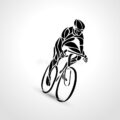How much wind is too much for cycling?
There will always be days when it is not advisable to ride a bike given that it will be too windy. While it may depend on the comfort level of the rider, a 20 mph wind is usually the point at which the wind starts becoming too much for cyclists.
Such a wind may make small trees sway and pick and blow small amounts of debris but some experienced riders may be able to navigate such wind speeds.
How Much Wind is too Much for Cycling?
Anything above 30mph is usually too much wind for any cyclist and may be hazardous and very difficult to ride in. Any winds above 40mph or 50mph are usually classified as gales and should never be ridden in as they are not only difficult to ride in but extremely hazardous for any cyclist.
How Dangerous are the Different Wind Speeds
There are different ranges of wind speed each of which comes with its own hazard with the lower levels being just difficult to ride in rather than hazardous.
10 mph Wind Cycling
At 10mph the wind speeds are very low and most experienced cyclists should not have any problem riding in such winds. A beginner will need to be more careful with such winds even though on its own, such speeds should be fine for every level of rider.
15 mph Wind Cycling
Wind speeds of 15mph will start causing cyclists trouble unless they are tailwinds. Such speeds may be potentially dangerous for intermediate and beginner cyclists and may result in accidents if the cyclist is negligent or not careful enough. However, this level of wind should just be a nuisance for experienced riders.
20 mph Wind Cycling
Cycling at 20mph is when things start getting tough as it would result in a significant reduction in speed for the cyclist. Even experienced riders would have to exert more energy and power and have to be content with a reduction in speed of up to 10mph. Nonetheless, even this speed should be manageable for the experienced cyclist.
Ideal Wind Speeds for Cycling
| Wind Speed | Rideability |
| >10 Mph | Easily Rideable – Safe |
| 15 Mph | Rideable – A little Tough |
| 20 Mph | Rideable – Tough |
| 30 Mph | Rideable – Very Hard |
| 40 Mph | Not Rideable |
| 50 Mph+ | Very Dangerous For Cycling |
Why is it Difficult to Ride Against the Wind?
Riding into winds often referred to as going into headwinds usually provides a lot of resistance from the wind which usually significantly reduces a cyclist’s speed.
According to the data, riders will usually lose about half of the windspeed when dealing with headwinds. For instance, a rider who will usually go at 17mph on the flats in non-windy conditions will only go at the slow speed of only 7mp when there is a headwind of 20mph.
Moreover, the decrease in speed does not usually result in an easier ride as is usually the case. The same power needed to ride through a 20 mph wind just makes for a grueling endeavor with less speed.
check out tips on how to cycle in the wind

Other Effects of Wind
Other than significantly reducing a rider’s speed, the wind can also push around and pick up objects such as sticks, dust, and rain which can be blown into the rider’s path and into them.
Depending on where one is riding these can be very dangerous not only for the bike but also for the safety of the rider. Dust, debris, and rain can make it hard to see while larger objects could strike the cyclist and cause injuries.
As such, it is important to take note of the conditions before riding out. In this regard, it is recommended to always have glasses that provide some kind of protection against grit and rain when riding in windy conditions.
Importance of Safety First Approach
It is critical for cyclists to remember that they would rather postpone their riding and stay inside than go out and regret it. For beginners, it is particularly critical to remember that they should not be afraid of canceling their ride if they believe the wind no matter how small is making them uncomfortable.
With more experience, cyclists will usually experience a variety of windy conditions and the necessary information on what they are able to handle and what they cannot. By having that information they can then have the confidence to decide when it is safe and when it is not safe to ride.


